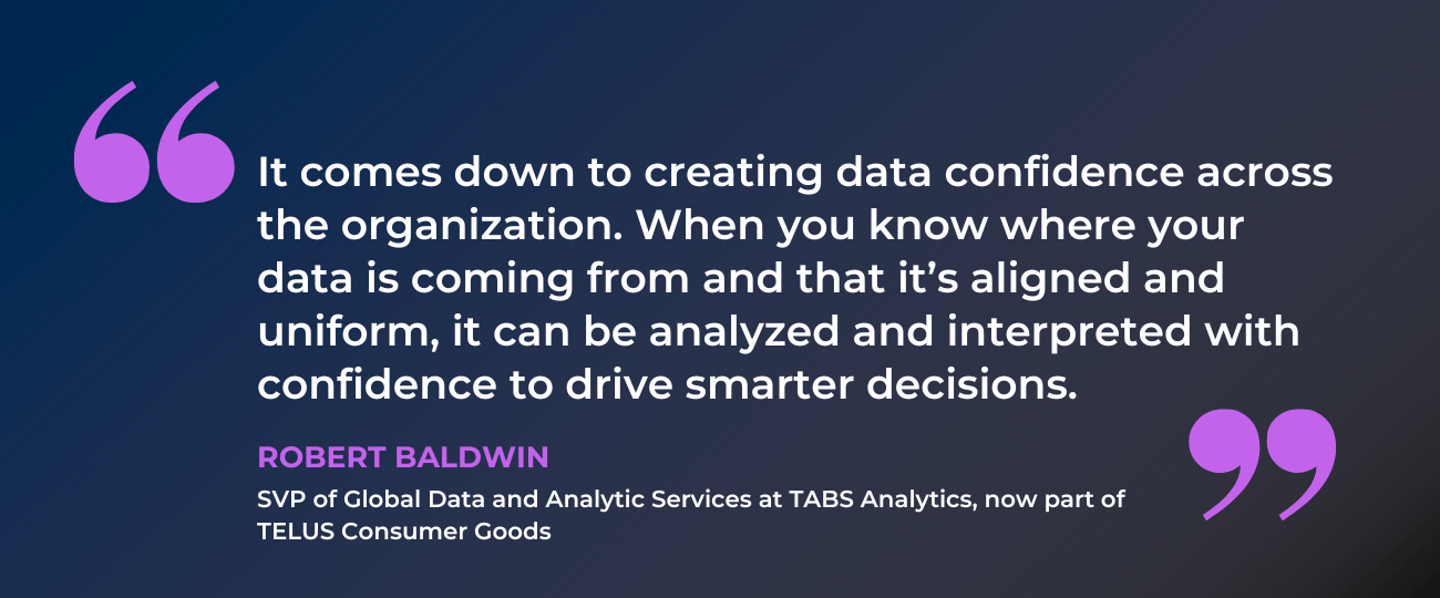Setting the Stage for Enterprise-wide Data Harmonization
The future of the consumer goods industry lies in analytics. The ability to gather, analyze and — most crucially — harmonize data is now a strategic differentiator. It allows companies to create more efficient knowledge-sharing systems and optimize processes at every touchpoint. Nowhere is this need more evident than in TPx, where precise planning and accurate forecasts have always been important to success.
The opportunities for improvement are limitless. By combining TPx and advanced analytics, CGs can harmonize data sets and break down silos, fashioning disparate information sources into clear, impact-driven channels of insight. In this conversation with CGT, Robert Baldwin, SVP of global data and analytic services at TABS Analytics, now part of TELUS Consumer Goods, outlines some of the evolving trends to watch in TPx while exploring some of the commonly-held beliefs around analytics, data harmonization, and trade services.
CGT: Why is harmonizing disparate data sources so critical in today’s consumer goods landscape?
Robert Baldwin: By 2025, experts predict the world will produce 180 zettabytes of data. The amount and variety are only increasing. Data harmonization is critical because it turns data overload into insights by breaking down information silos that develop within consumer goods manufacturers. Instead of spending time downloading, gathering, and dissecting brand and product performance data, CGs who rely on data harmonization can redirect their time to finding business-driving insights.
It comes down to creating data confidence across the organization. When you know where your data is coming from and that it’s aligned and uniform, it can be analyzed and interpreted with confidence to drive smarter decisions.
CGT: What are some of the immediate and long-term benefits CGs can expect to see across their organization upon investing in data harmonization?
Baldwin: The first immediate benefit is centralization. When all the data is in one area, it helps cut down on confusion and improve efficiency. If a team member needs to quickly pull information about a sales promotion, they can visit one database versus going to several departments.
Next is competitive advantage. When CGs harmonize their unique datasets, they can unlock insights that aren’t obvious when analyzing only one dataset. Standalone reports are commonplace. Multi-dimensional, harmonized tools offer a competitive advantage.
Long term benefits start with efficiency savings. Every time a team member must scramble through different databases to find a specific source, that’s time that could be better spent elsewhere. Reducing inefficiency means each piece of data is more profitable in the long term.
There are also data governance benefits. If you have disparate data sets, rebrands, new items or consolidations can get lost and misguided. Data harmonization makes adapting to these changes easier.
CGT: What are some of the most common trade promotion management challenges today, and how can the combination of TPx and analytics help overcome them?
Baldwin: Trade promotion profitability is a challenge. The POI Institute suggests that 45% of CG companies spend 20-30% of their revenue on trade spend, and as many as two thirds of promotions don’t break even. When trade promotion management and analytics come together, CGs can determine which promotions were and were not profitable, allowing for more productive planning sessions.
Forecasting is another common challenge. CG companies have a hard time predicting and forecasting promotional outcomes, leading to over and under stocks. This challenge can be solved with a baseline that accurately represents base volume, allowing for more precise incremental volume calculations.
CGT: What are some common misconceptions you continue to see surrounding TPx — and data and analytics more broadly — and how would you debunk them?
Baldwin: MYTH: “Implementation is long and requires heavy internal IT resources.”
Your vendor should shoulder most of the implementation resources. When you can combine analytics and trade services with one vendor, you can get started analyzing promotions quickly while other longer trade management processes are underway.
MYTH: “Analytics sounds cool, but it’s only for the consumer insights group.”
Every team can and should access data to guide strategy. When data is harmonized across the organization, turning to the data for decision making is second nature, because it’s easy and fast to glean insights on pricing, volume, and performance trends.
MYTH: “You can only optimize retail trade events once a year … What’s the point of investing in an application?”
With trade promotion performance analytics in hand, CGs can show retailers how much incremental revenue could be made if tactics are changed more often than the usual once-per-year timeline.






